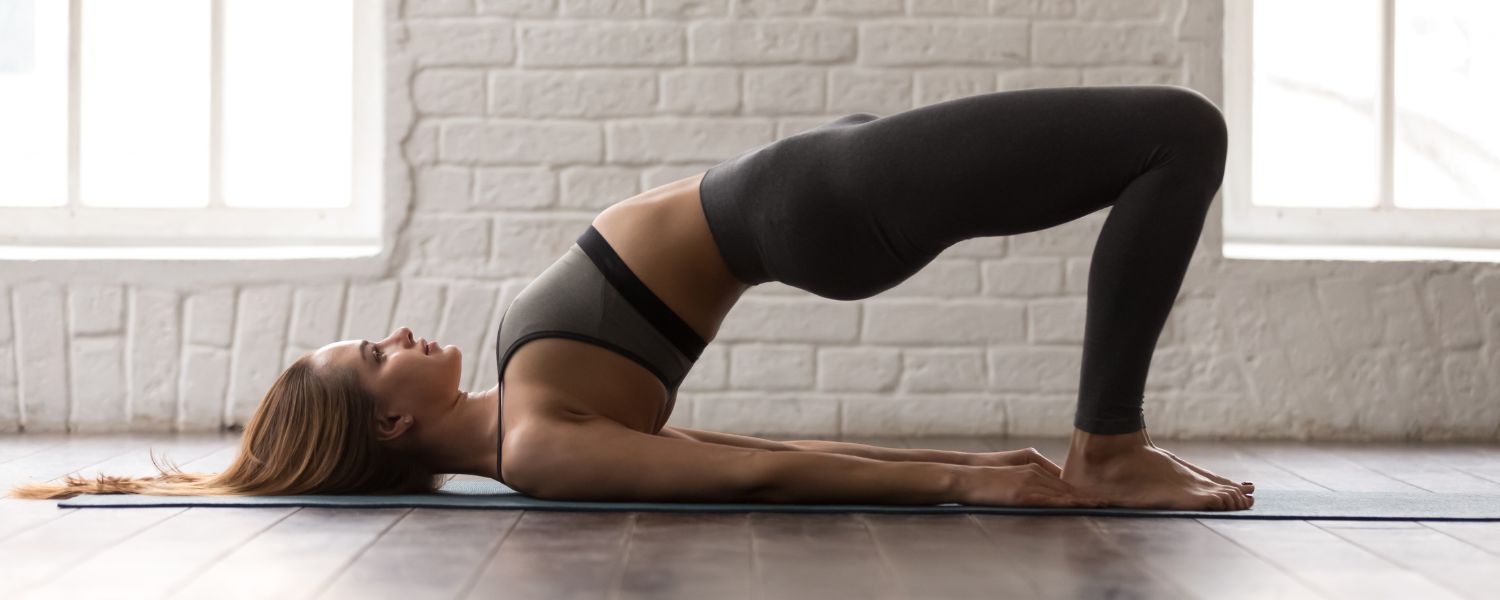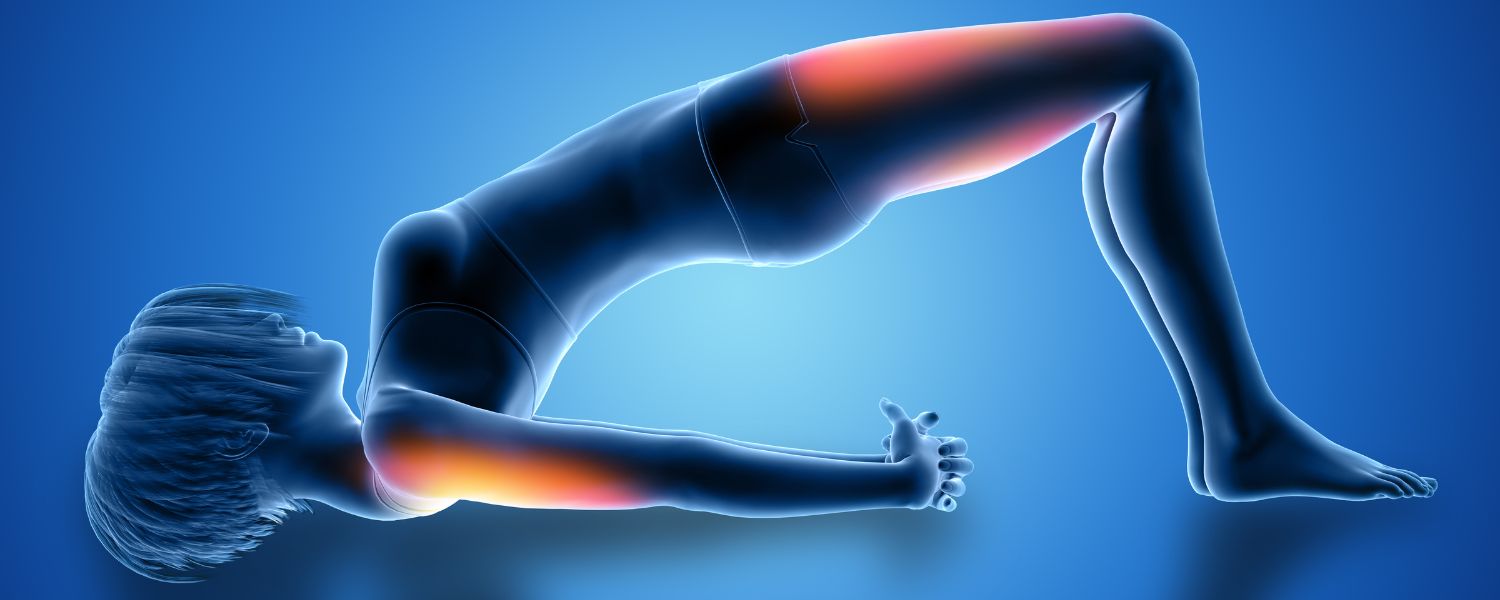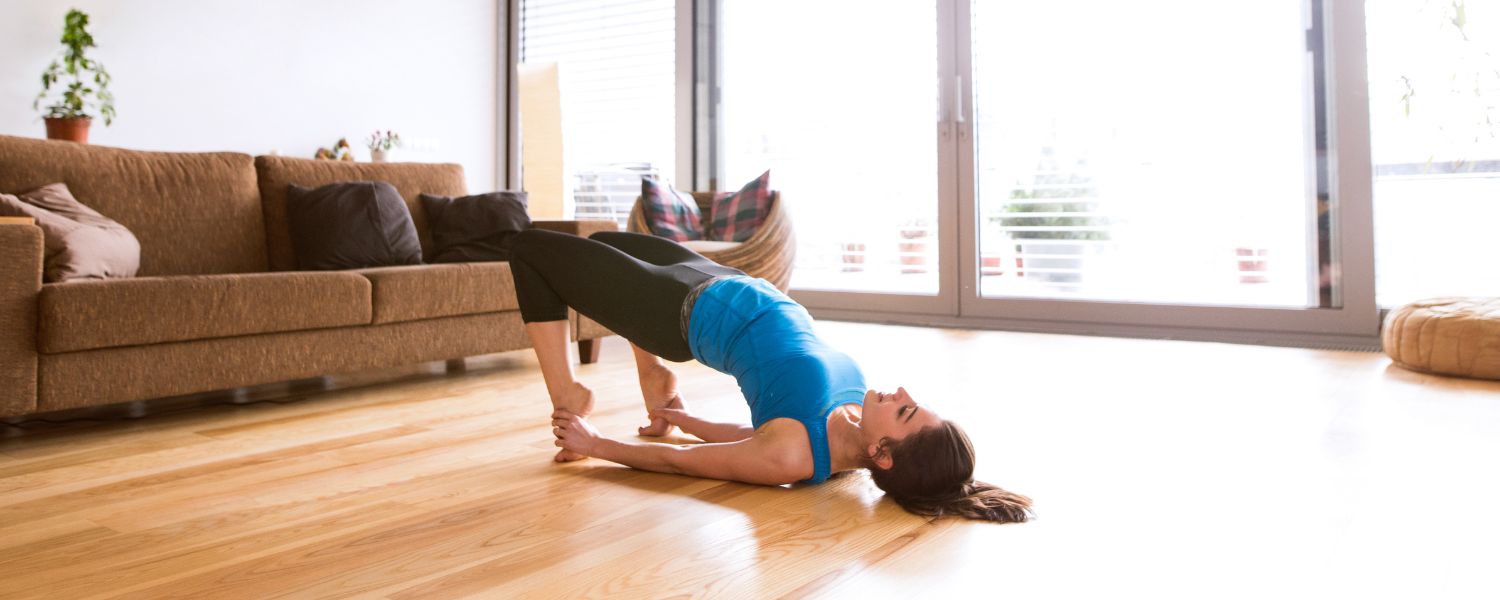The bridge pose is a fundamental asana that offers many physical and mental benefits in yoga. Also known as Setu Bandha Sarvangasana in Sanskrit, this pose is revered for bridging the gap between various aspects of our being, creating harmony and balance.
What is Bridge Pose?
Bridge pose, known as Setu Bandha Sarvangasana in Sanskrit, is a yoga posture where one lifts their hips off the ground while lying on their back. This action creates a bridge-like shape with the body, stretching and strengthening the spine, chest, neck, and hips. This pose is often used as a gentle backbend and is known for stretching and strengthening the spine, chest, neck, and hips.
Sanskrit Meaning (Setu Bandha Sarvangasana)
In Sanskrit, "Setu" means bridge, "Bandha" means lock, and "Sarvangasana" means all limbs pose. The name signifies how this pose creates a bridge-like structure with the body while engaging multiple limbs to support the posture.
Bridge Pose Basics
The bridge pose yoga, also known as Setu Bandha Sarvangasana, is a foundational yoga posture that offers numerous benefits for the body and mind.
Here are the basics of how to practice bridge pose effectively:
1. Alignment
Ensure that your feet are parallel to each other and evenly planted on the ground. The distance between your feet and your hips should be comfortable, allowing stability and support.
2. Engagement
Press firmly into the soles of your feet as you engage your leg muscles, particularly the quadriceps and glutes. This activation will help to lift your hips off the ground and create a stable foundation for the pose.
3. Breath
Once lifted into the pose, breathe deeply and evenly. Allow the breath to flow freely through your body, bringing a sense of ease and relaxation to the pose.
4. Duration
Hold the bridge pose for several breaths, allowing your body to settle into the posture and reap the benefits. Aim to gradually increase the duration of your hold as you become more comfortable with the pose.
5. Release
To release the pose, exhale as you gently lower your hips to the mat. Take a moment to rest in a neutral position, allowing your spine to realign and your body to integrate the effects of the pose.
Benefits of Bridge Pose
Bridge pose, or Setu Bandha Sarvangasana, offers many bodily and mental benefits. Incorporating this pose into your yoga practice transform your overall well-being.
Here are some of the benefits of practicing bridge pose yoga:
1. Strengthens the Back
The bridge pose is an excellent way to support the back muscles, including the erector spine and quadratus lumborum muscle. Lifting the hips off the ground engages these muscles, which improves posture and reduces the risk of back pain and injury.
2. Stretches the Spine
As you lift into bridge pose, you create space between the vertebrae, which can help to alleviate compression and tension in the spine. This gentle stretching action can improve flexibility and mobility in the spine, promoting overall spinal health.
3. Opens the Chest and Shoulders
Bridge pose yoga opens the chest and shoulders, counteracting the effects of poor posture and hunching. By expanding the chest and stretching the pectoral muscles, bridge pose can improve respiratory function and enhance lung capacity.
4. Calms the Mind
The bridge pose is a gentle inversion, meaning the head is below the heart. This inversion contains the nervous system, reducing stress, anxiety, and mental fatigue. Practicing bridge pose can help to promote feelings of relaxation and tranquility.
5. Improves Circulation
By lifting the hips towards the ceiling, the bridge pose yoga increases blood flow to the brain, promoting mental clarity and alertness. Additionally, the inversion of the pose encourages venous return, which can help to reduce swelling and inflammation in the legs and feet.
6. Energizes the Body
While the bridge pose has a calming effect on the mind, it also has an energizing effect on the body. By engaging the muscles of the legs and hips, the bridge pose increases circulation and vitality, leaving you feeling rejuvenated and invigorated.
7. Relieves Menstrual Discomfort
Bridge pose yoga can particularly benefit women experiencing menstrual discomfort. The pose's gentle backbend helps alleviate cramps and discomfort in the lower abdomen, providing natural relief from menstrual symptoms.
8. Therapeutic for Respiratory Conditions
Bridge pose can be therapeutic for respiratory conditions such as asthma and bronchitis. Expanding the chest and lungs in a bridge pose yoga improves lung function and increase oxygenation, making breathing easier.
Cautions & Contraindications
While bridge pose, or Setu Bandha Sarvangasana, offers numerous benefits for the body and mind, practicing this pose mindfully and with awareness of any potential contraindications is essential.
Here are some cautions and contraindications to consider before practicing bridge pose yoga:
1. Neck or Spinal Injury
Individuals with a neck or spinal injury should approach bridge pose with caution or avoid it altogether. The backbend action of the pose can exacerbate existing injuries and strain the delicate structures of the neck and spine.
2. Pregnancy
Pregnant women should modify or avoid bridge pose, especially in the later stages. The pressure on the abdomen and the compression of the pelvic area in the bridge pose yoga can be uncomfortable and potentially harmful for both the mother and the baby.
3. Recent Abdominal Surgery
Individuals who have undergone abdominal surgery should avoid bridge pose until fully healed. The pressure on the abdominal area in the bridge pose yoga can strain the surgical site and impede the healing process.
4. High Blood Pressure
While bridge pose can be beneficial for individuals with mild to moderate high blood pressure, those with uncontrolled or severe hypertension should avoid this pose. The inversion of the pose can increase blood pressure in some individuals, potentially exacerbating hypertension.
5. Glaucoma
Individuals with glaucoma should approach the bridge pose cautiously, as the inversion of the pose can increase intraocular pressure. Practicing bridge pose yoga may exacerbate symptoms and potentially damage the optic nerve in individuals with glaucoma.
6. Osteoporosis
Individuals with osteoporosis or low bone density should be cautious when practicing bridge pose, especially if they have compression fractures in the spine. The backbend action of the pose can put pressure on the vertebrae and increase the risk of further injury.
7. Sciatica
Individuals with sciatica should approach the bridge pose yoga with caution, as the backbend action of the pose can exacerbate symptoms of sciatic nerve pain. Listening to your body and avoiding any movements or positions aggravating discomfort or pain is essential.
8. Joint Issues
Individuals with everyday issues, such as arthritis or injury, should approach the bridge pose cautiously and may need to modify the pose to avoid strain on the affected joints. It's essential to honor your body's limitations and practice with an awareness of any discomfort or pain.
How to Do Bridge Pose
Bridge pose, also known as Setu Bandha Sarvangasana, is a foundational yoga posture that yogis of all levels can practice.
Follow these step-by-step instructions to perform bridge pose yoga safely and effectively:
1. Begin in Supine Position
Begin your practice by reclining on your back in a supine position on a yoga mat, ensuring that knees are bent and feet are firmly planted on the floor. Your feet should be hip-width apart, and your arms should rest alongside your body with palms facing down.
2. Align Your Body
Take a moment to ensure proper alignment of your body. Your spine should be neutral, with a natural curve in your lower back. Your shoulders should be relaxed and pressed gently into the mat.
3. Engage Your Core
Engage your abdominal muscles on an exhale by drawing your navel towards your spine. This engagement will help to stabilize your core and protect your lower back as you move into the pose.
4. Press Into Your Feet
Firmly press into your feet as you elevate your hips towards the ceiling. Maintain an even distribution of weight between both feet, and be mindful to prevent any tendency to roll onto the outer edges or balls of your feet.
5. Lift Your Hips
Press into your feet as you lift your hips, creating a bridge-like shape with your body. Aim to lift your hips as comfortably as possible while maintaining stability and balance.
6.Open Your Chest
As you lift into bridge pose yoga, allow your chest to open and expand towards the ceiling. Roll your shoulders back and down to create space across the front of your chest. Avoid tensing your neck or shoulders, and keep your chin slightly tucked towards your chest.
7. Breathe
Once you have lifted into the pose, focus on deepening your breath. Inhale deeply through nose, expand your chest and belly, and exhale fully through your mouth, releasing any tension or stress.
8. Hold the Pose
Hold the bridge pose for several breaths, maintaining steady breathing and focusing on the sensations in your body. If you feel discomfort or strain, gently lower your hips to the mat and rest briefly before trying again.
9. Release the Pose
To release bridge pose, exhale slowly and lower your hips back down to the mat, one vertebra at a time. Take a moment to rest in a neutral position, allowing your spine to realign and your body to integrate the effects of the pose.
10. Rest and Reflect
After practicing the bridge pose, take sometime to rest in Savasana (corpse pose) or a comfortable seated position. Notice how your body feels and observe changes in your breath, energy, or state of mind.
Beginner Tips
Bridge pose, or Setu Bandha Sarvangasana, is a beneficial yoga posture accessible to beginners with the right approach.
Here are some tips to help beginners practice bridge pose yoga safely and effectively:
1. Start Slow
If you're new to yoga or bridge pose, slowly and gradually build up your practice over time. Try to avoid pushing yourself too hard or attempting advanced variations before you're ready.
2. Warm-Up
Before practicing bridge pose, warm up your body with some gentle stretches and movements. Focus on the spine, hips, and thighs to prepare your body for the pose.
3. Use Props
Don't hesitate to use props such as a yoga block or bolster to support your practice. Placing a prop under your sacrum can help to lift and keep your hips, making the pose more accessible and comfortable.
4. Listen to Your Body
Honor your body's limitations and listen to the signals it sends you. If you feel discomfort or pain in the bridge pose yoga, gently come out and rest.
5. Modify as Needed
Feel free to modify the bridge pose to suit your body's needs. If lifting your hips off the ground feels too challenging, try a supported bridge pose with a prop under your sacrum. You can also explore variations such as half-bridge poses to build strength and flexibility gradually.
6. Be Patient
Rome wasn't built in a day, nor is your yoga practice. Be patient with yourself as you explore bridge pose and other yoga postures. Celebrate your progress along the way, and trust that you'll continue to grow and improve with consistent practice.
Teaching Bridge Pose
As a yoga instructor, guiding students through bridge pose, or Setu Bandha Sarvangasana, requires clear instructions, proper alignment cues, and modifications for all levels. Here's how you can effectively teach bridge pose to your students:
1. Introduction
Begin by introducing the bridge pose to your students, explaining its benefits and the key muscles involved. Emphasize that the bridge pose is a gentle backbend that strengthens the back, opens the chest, and stretches the spine.
2. Warm-Up
Before practicing bridge pose, lead your students through a gentle warm-up sequence to prepare their bodies. This may include cat-cow stretches, pelvic tilts, and gentle spinal twists to mobilize the spine and hips.
3. Demonstration
Demonstrate bridge pose yoga for your students, showing proper alignment and engagement of the muscles.Use your body as a visual guide, and encourage students to observe before attempting the pose themselves.
4. Alignment Cues
Provide clear alignment cues as students move into bridge pose.Encourage them to align their feet hip-width apart, press firmly into their feet, and lift their hips towards the ceiling while keeping their knees aligned with their ankles.
5. Breath Awareness
Remind students to synchronize their breath with movement as they transition into bridge pose yoga.Inhale as they prepare, and exhale as they lift their hips off the mat. Encourage them to maintain steady, even breaths throughout the pose.
6. Modification
Offer modifications and props to accommodate students of all levels and abilities. For beginners, suggest placing a block or bolster under their sacrum for support. Encourage more advanced students to lift one leg towards the ceiling or interlace their fingers under their back for a deeper stretch.
Bridge Pose Variations
Bridge Pose, or Setu Bandha Sarvangasana, offers a variety of variations that cater to different levels of practitioners and address specific needs.
These variations provide opportunities to deepen the pose, enhance its benefits, or accommodate individual differences.
Here are some common variations of bridge pose yoga:
1. Supported Bridge Pose
This variation involves placing a prop, such as a yoga block or bolster, under the sacrum for added support.
To practice the supported bridge pose, follow the steps for the traditional bridge pose, but instead of lifting the hips directly off the floor, place the prop under your sacrum before lifting.
This variation is excellent for beginners or individuals with limited flexibility and can help release tension in the lower back.
2. One-Legged Bridge Pose
In this variation, one leg is extended straight up towards the ceiling while the other foot remains grounded on the floor.
To practice the one-legged bridge pose, begin in the traditional bridge pose and lift one leg towards the ceiling, keeping the knee straight.
This variation strengthens the glutes and hamstrings while also challenging balance and stability.
3. Elevated Bridge Pose
Elevating the feet or hands in the bridge pose can intensify the stretch and increase the challenge.
To practice an elevated bridge pose, place your feet on a high surface, such as a yoga block or bench, or interlace your hands under your hips for additional support.
This variation can deepen the stretch in the shoulders, chest, and hips while strengthening the legs and core.
4. Half Bridge Pose (Ardha Setu Bandhasana)
Half bridge pose is a gentler variation of bridge pose that targets one side of the body at a time.
To practice half bridge pose, begin in traditional bridge pose and lower one hip towards the ground while lifting the other hip.
This variation provides a deep stretch for the hips and thighs and can help alleviate tension and discomfort in the lower back.
5. Dynamic Bridge Pose
Dynamic bridge pose involves moving in and out of the pose with the breath, flowing smoothly between the lifted and lowered positions.
To practice dynamic bridge pose, inhale as you lift your hips toward the ceiling and exhale as you lower them back down to the floor.
Repeat this movement several times, synchronizing your breath with the movement of your body.
This variation increases spine and hip mobility while promoting relaxation and stress relief.
What to Avoid When Doing the Bridge Yoga Pose
When practicing bridge pose yoga, it's essential to avoid the following:
- Overarching the lower back
- Holding your breath
- Pressing into the neck or shoulders
- Straining or forcing the pose
Conclusion
Bridge pose yoga, also called Setu Bandha Sarvangasana, is a cornerstone posture in yoga, renowned for its transformative effects on both body and mind.
This foundational pose connects different dimensions of your being, fostering harmony and equilibrium within. Whether you are starting your yoga journey or have been practicing for years, incorporating bridge pose into your routine can yield profound benefits.
This pose is critical to enhancing your holistic wellness journey, from bolstering physical strength to calming the mind. Embrace the supine posture yoga offers and pair it with the comfort and sustainability of bamboo activewear for an eco-conscious practice.
Complete your ensemble with flare yoga pants that offer freedom of movement, allowing you to immerse yourself fully in the transformative power of bridge pose. Experience the synergy of mind, body, and spirit as you explore the depths of this timeless yoga posture.













